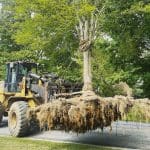
Palm trees have once again come under fire for their place in the landscape and this time it is Southern California questioning their shade capabilities as the region seeks to expand their urban tree canopy.
Canopy cover is a serious topic of discussion as urban areas seek to combat increasing temperatures, drought and air pollution. According to the Los Angeles Times, shade trees provide more than 2.3 million square feet of canopy cover across the city, while palms only provide 321,857 square feet.
In San Diego alone, the city’s 2017 Urban Forestry Plan calls for increasing their canopy cover from around 13 percent to 30 percent by 2028 and 35 percent by 2035. Their climate action plan outlines that new development can only use palm trees when identified in the applicable community plan. When palm trees are used, more are required to be planted than shade trees.
According to Bloomberg, a study conducted of three tree groves in Tel Aviv found that palms provide the least amount of shade and required the most amount of water, up to 1,000 liters per day. While palm trees chilled the air less than one degree, ficus and rosewood tress managed to cool the surrounding area by seven degrees and three degrees, respectively.
It’s also important to note that while they are referred to as trees, palms are actually more closely related to grasses.
History of Palm Trees in California
Despite the visuals of palm trees being synonymous with iconic sections of California, majority of palm trees are not native to the region. Only the desert fan palm (Washingtonia filifera) is native to the state.
It’s said palm trees were introduced to the area in the 1700s by Spanish missionaries and since then, the palms have proliferated Southern California. Palm trees later became a symbol of status and glamor as the elite began to add these trees to their estates.
Four species that are most commonly found in Southern California include Mexican fan palms, South American queen palms, tapered king palms and Canary Island date palms.
While aesthetically pleasing, most cities are starting to recognize palm trees are not the best choice for urban landscapes. Despite the fact palms do not provide much shade, require significant water and have a propensity to catch fire, residents are particularly attached to their palm trees and have protested their removal.
Threats to Palm Trees
Even as the public fights to keep their beloved palms, there are a number of factors whittling down their lifespans.
The South American palm weevil is a major killer of Canary Island date palms and as temperatures increase, the palms are more stressed and vulnerable to these insects. Palms impacted often have a halo of green fronds around the apex of the trunk and the palm crown has disintegrated.
The fungus fusarium is also proving to be a problem as this fungus spreads through spores and the wind can carry the spores to other neighboring palms when an infected one is cut down. Once a palm is infected, it is beyond saving.
In other cases, palms are struggling after being transplanted. In Sacramento, 141-year-old palm trees were moved to make room during the demolition of the Capitol Annex and the transition has left the trees distressed.
It is expected as more palms die off, they will be replaced with more beneficial shade trees in urban areas.
However, it is unlikely that palm trees will disappear entirely from the California skyline as homeowners and developers will still continue to plant palms.


